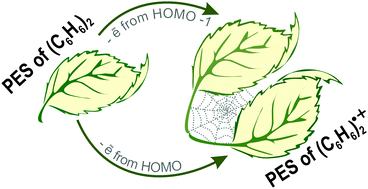На сайте журнала Physical Chemistry Chemical Physics, (IF 3,945) опубликована статья сотрудников Института: д.х.н. Л.Н. Щеголевой (внс, ЛЭАСМ), и к.х.н. И.В. Береговой (снс. ЛЭАСМ)
Potential energy surfaces of a stacked dimer of benzene and its radical cation: what remains and what appears
Irina V. Beregovayaand Lyudmila N. Shchegoleva
Phys. Chem. Chem. Phys., 2022,First published on 29 June 2022
doi: 10.1039/D2CP01691E

Abstract
A stepwise qualitative consideration of the reduction in symmetry for the highly symmetrical “right sandwich” and “twisted sandwich” structures of the stacked benzene dimer caused by the pseudo-Jahn–Teller effect made it possible to construct a scheme of the potential energy surface (PES) of this dimer. Thirty-six equivalent structures of minimum energy are ordered on this extremely flat surface, transforming into each other in an almost barrier-free manner. There are two kinds of these transformations, both of which are pseudorotation. The transformation pathways inherent in this neutral dimer are also characteristic of its radical cation (RC). Structural transformations of the RC are inextricably linked with changes in its electronic state since its stationary structures relate to different electronic states. (C6H6)2+˙ exists in the form of two orbital isomers, each of which “pseudorotates” on its own area of the PES. During the pseudorotation, the SOMO distribution on the fragments of (C6H6)2+˙ changes, which is identical to what occurs during the pseudorotation of the Jahn–Teller benzene RC. These areas are connected by pairwise interconversions of their minimum energy structures. The interconversion of the orbital isomers is a bypassing of conical intersections between corresponding electronic states, which occurs through a synchronized pseudorotation of the fragments. The conclusions of the qualitative consideration and the results of quantum chemical calculations of various levels performed for (C6H6)2+˙ are in full agreement with each other. The revealed features of the structure of the PES of the two reference systems in studying the intermolecular and ion–molecule interactions are the basis for considering their more complex analogs, primarily their less symmetrical ones.
Альметрики:


